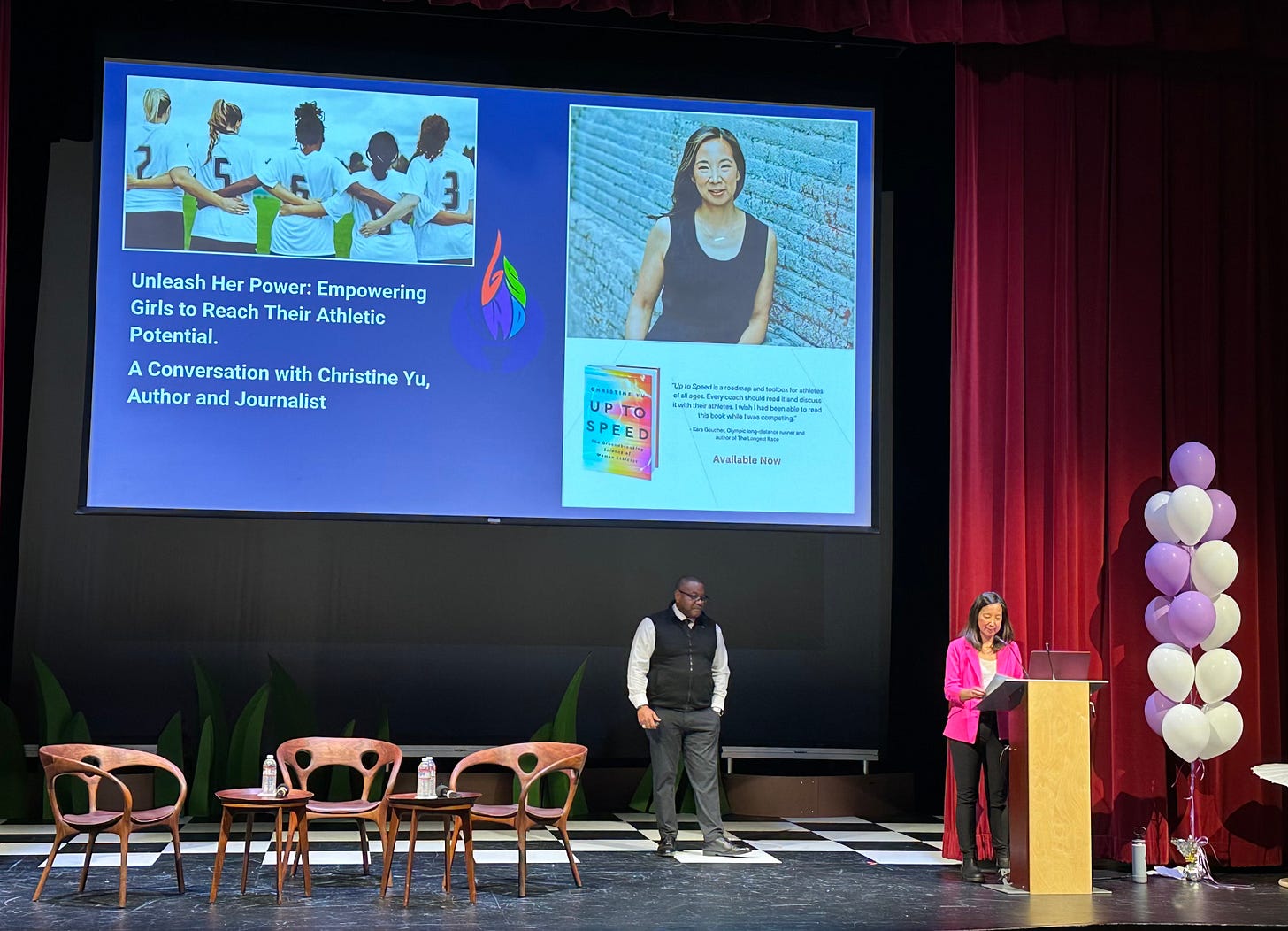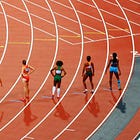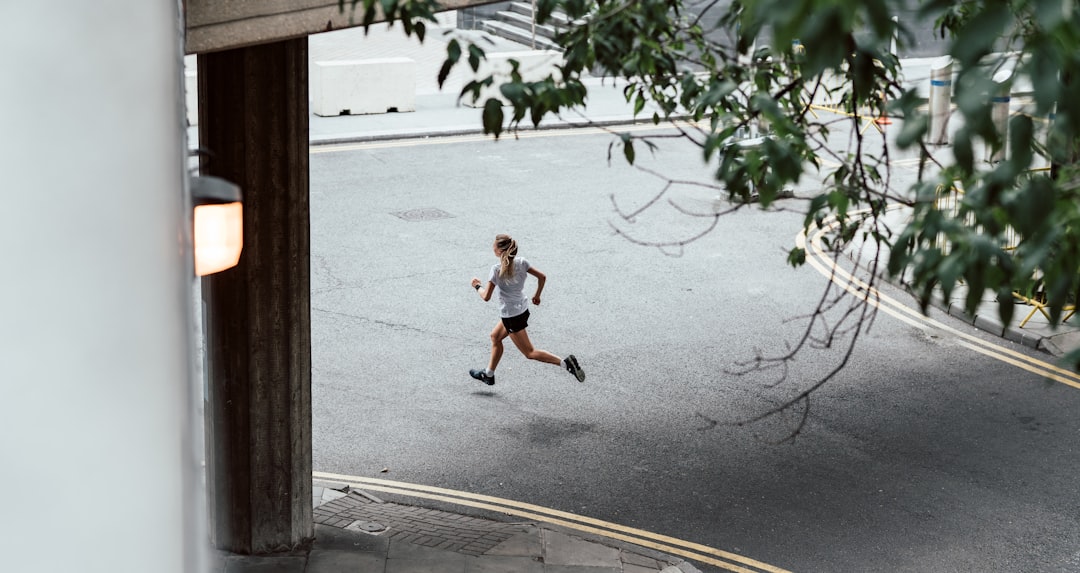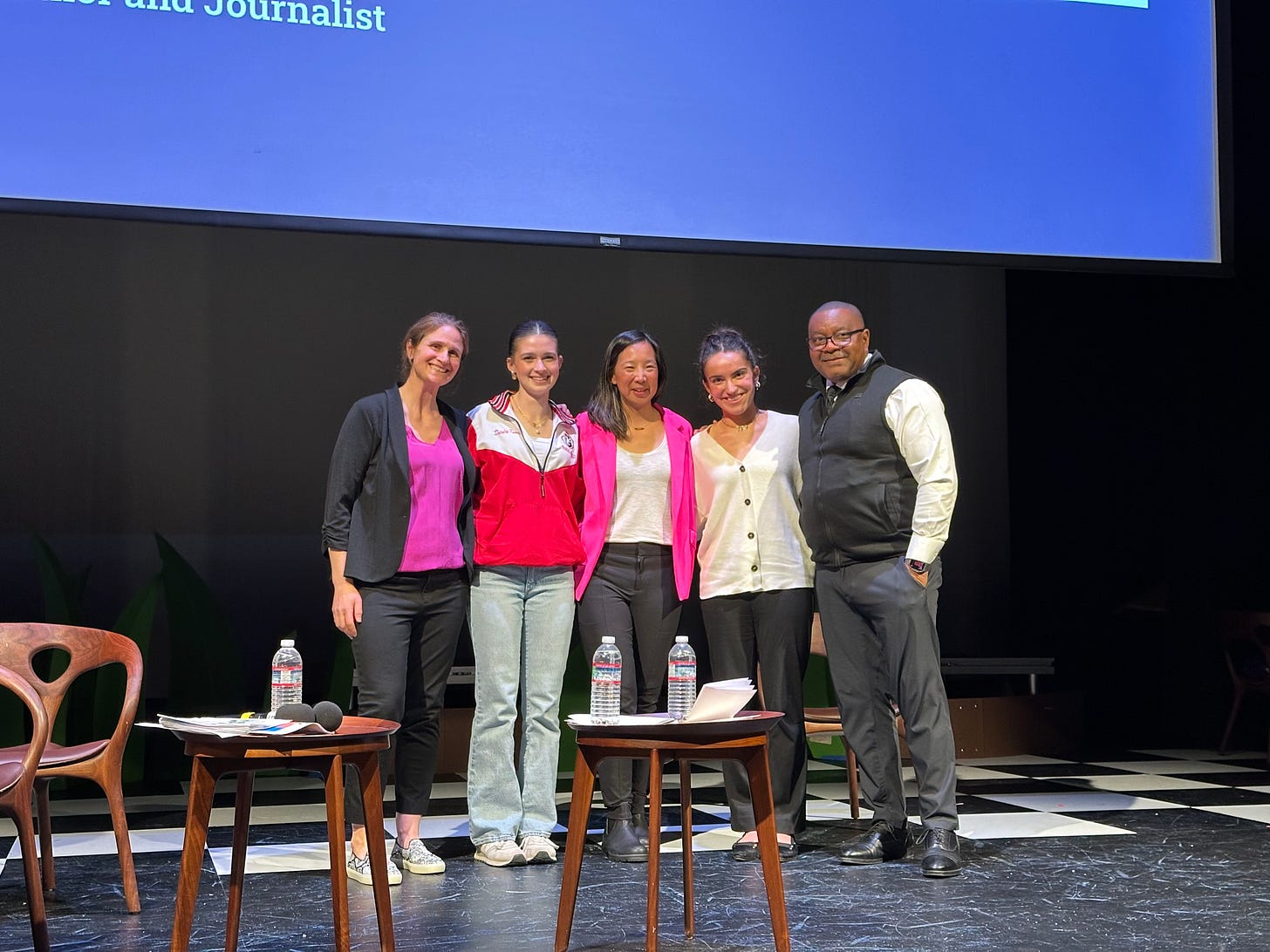Girls Drop Out of Sports at Twice the Rate of Boys by Age 14. What Can We Do?
Advice for coaches and parents on how to support and empower girls in sport
Earlier this month, I was in San Francisco to celebrate National Girls and Women in Sports Day. I was invited by the Bay Area Athletic Conference, the National Organization of Minority Athletic Directors, Convent & Stuart Hall, and San Francisco University High School to talk about what it takes to unleash the power of girls in sports.

While it was an honor to be asked to share my thoughts on such an important topic, the real honor was being interviewed by two incredible student athletes. I feel like I say this every time I have a chance to interact with high school or college students but wow. These two young women were so poised and asked such smart questions, but more than that, they get it. They get the issues at the heart of these questions about sport and athletics and the change that need to happen.
And they give me so much hope because I know that there are young people like these two young women and countless others who know that they deserve a better system of sports and want to do something about it.
At the end of the session, I was asked what advice I’d give to men who coach girls. It’s a question I’m often asked at these types of events. And I get the impulse. Men have a steeper learning curve in some respects but my answer applies to everyone and anyone who coaches girls or interacts with them. Frankly, my answer applies to all kids too.
If we’re talking about reaching one’s athletic potential, I think—I hope—that we’re talking about success and health over the long-term. That we want girls and young people to be lifelong active people and athletes. That we don’t want them to be burnt out and injured or hate sports by the time they graduate high school or college.
Fundamentally, adolescence is a critical time in a young person’s relationship between their body, movement, and sport. But right now, girls are more likely to suffer from overuse injury, burnout, and major injuries compared to boys. They also more likely to experience body image issues and disordered eating. They more likely to walk away from sports and physical activity entirely compared to boys.
So what are some things we can do to nurture that relationship?
Prioritize health first over athletic outcomes
What I mean by this is that when we see a young person perform well, that athletic success is alluring and exciting. We want them to continue to improve and move up this linear trajectory, to get better and faster because we see a spark of something special.
It’s a common story we hear in sports like cross country (see Lauren Fleshman’s book Good for a Girl) where young girls run really well—a phenom!—but then start to slow down as they go through puberty. We start to ask, “What’s wrong with her?” or think that she just needs to train harder and more. Consciously or not, we identify body composition changes and puberty as the culprit. Naturally, other girls look around and may start to think that puberty is a bad thing, that if they can just keep their body from changing, they’ll continue to run fast. This can lead to overtraining and restrictive eating habits. It can lead to thinking that menstrual cycles are a bad thing and if you don’t get your period, it’s a good thing. It means you’re fit.
We don’t always acknowledge the reality of 1) young, developing bodies and what that literally means in terms of bones, joints, and muscles, and 2) the increasing expectations of athletic training and performance and how there’s often a mismatch between the two.
But we need to respect the maturation process and bodies need to go through puberty. The physical maturation process is critical. Those Olympians and pro athletes that young athletes look up to? They’re adults and are playing at that level in their adult bodies and that requires going through puberty.
A big factor is the menstrual cycle because menstrual health is like a vital sign, akin to your pulse or breathing rate. It gives you insight into what’s going on inside your body, especially with regard to hormonal health. And hormones matter, not just for fertility. They play an important role in bone health and developing bone mass as an adolescent. (You lay down 80% of your adult bone mass by your early 20s. If you miss this chance, there’s no catching up and you’re at higher risk for bone stress injuries and early onset osteoporosis.) Hormones also play an important role in pretty much every system in the body, from cardiovascular health to strength to brain health.
As parents and coaches, that means understanding that a healthy cycle is critical for a young person’s health and development and that if anything is going on with a person’s cycle, it’s a red flag and something to pay attention to.
Side note: Hormonal birth control does not restore your menstrual cycle! Bleeding while on hormonal contraceptive can make it seem like you have your period but it’s not a true period (more on that here) and instead can mask underlying issues leading to absent or irregular cycles.
So, health first. Always.
And not just menstrual health but also musculoskeletal health, nutrition, recovery, sleep, mental health. Athletic performance should never come at the expense of overall health.
Learn about female physiology and health
In order to do Number 1, you have to learn about female physiology and health. It doesn’t mean you need a Ph.D. or talk about it every day with your athletes, but it does mean understanding the developmental stages of a female body and what supports their health and development now and in the long-term.
If we’re talking about factors that influence how someone shows up for training or on game/race/match day, we need to think about menstrual cycles. Not in terms of how to sync cycles to certain types of workouts or how to take advantage of hormonal surges and lows.
It’s because things like cramps, heavy bleeding, headaches, fatigue, bloating, and any number symptoms can affect how you feel physically and therefore your motivation to train and how you perform. It’s because the vast majority (somewhere around 90%) of people who menstruate experience at least one cycle related symptom and studies have found that people will change their exercise routine or skip workouts entirely because of it. And yet, we don’t talk about it so people are expected to just grin and bear and get on with their workout.
So it’s becoming literate about female physiology and encouraging young people to become literate about their own bodies. To notice what’s going on or when something feels off. To normalize periods because they are just part of female physiology and the daily lived experience of those with female bodies, just like the musculoskeletal or cardiovascular system. Because when you can recognize trends in your symptoms, you’re better able to anticipate them and potentially mitigate them.
Bring in reinforcements
Especially a sports dietitian. Not only is adolescence a prime time for dieting and restrictive eating practices to set in, nutrition is so critical during this phase of life. Kids need to eat to support the tremendous growth they’re experiencing and hormonal health.
But, as a mom of two teenagers, I’ve seen how hard it can be for kids to eat enough or consistently throughout the day. They wake up early, have class all day (with maybe a 30-45 minute lunch break), have a full slate of extracurriculars and sports practices, and often come home late. One of my kids eats breakfast before 7am but doesn’t have lunch until 1pm, six hours later.
A sports dietitian not only can help educate kids on the importance of fueling their bodies but help them develop strategies for what that means in their life.
No body talk
No talking about bodies. No comparing bodies. No shaming bodies. No body surveillance or public weigh-ins. While body composition can play a part in athletic performance, it is not the only factor or final arbiter of performance. Any talk of weight should be between the athlete, parent, and medical professional, full stop.
Practice patience
Adolescence is a period of transition and we need to give kids time and space to develop according to their own timeline. When athletic progression dips and kinks, it’s not a decisive sign of future failure but it could very well be a catalyst for kids to drop out of sport and physical activity together.
Rather, we should be nurturing kids and encouraging them to ride out those down periods because it’s normal and human. It takes time to adjust to this new and changing body.
There are ways to potentially adjust training to work with young athletes’ changing bodies rather than continuing to highlight all the ways in which their bodies are different from before. One expert I spoke told me about a period many gymnasts go through where they have difficulty doing skills they’ve done their whole life because their bodies have changed. Their limbs are longer. Their center of gravity is different. Instead of continuing to work those skills over and over again—and potentially breed frustration in the athlete—coaches could pull back from those specific workouts and focus on something else that would continue to develop the athlete and build confidence instead. It’s not a permanent shift but a temporary one that works with, rather than against, the athlete’s body.
Keep it fun
That’s why most of us starting playing sports, right? Sports should be fun.
Sometimes, I feel like we’ve lost sight of sports as this amazing developmental tool and space to experiment, practice different skills, and get to know your body. We lose sight of this because the system of youth sports right now over-emphasizes early specialization and an always-win culture, especially when things like college scholarships and going pro are dangled in front of every family as an achievable goal.
And this is despite the overwhelming research that has found that early specialization isn’t the key to long-term success. So many professional athletes played multiple sports as kids, specialized later, and progressed slowly and deliberately through their sport.
Instead, help kids develop the love of movement. Expose them to lots of different forms of movement. This variety builds a solid foundation for movement that makes them good overall movers and athletes. Once you have this, they can then layer sport-specific skills later.
One of the best gifts we can give kids to to help them develop a love of movement—any kid of movement—and make it fun because it should be fun.
These ideas are pretty broad and just a start. There’s a lot more we can and should do.
I’m curious, what else would you suggest? What changes would you like to see? Would you share in the comments?
Links and Things
Sabrina vs. Steph: Did you watch the 3-point challenge between New York Liberty’s Sabrina Ionescu and Golden State Warriors Steph Curry on Saturday? Steph won 29-26—but Sabrina’s 26 points tied Damian Lillard’s score, who won the NBA contest.
I’ve been thinking about it a lot, especially after seeing all the commentary on Sunday morning. It felt like a no-win situation.
discussed this in their Sunday newsletter and it’s a really great take on the whole “men vs. women” spectacle.But here’s the thing: women’s sports don’t have to look like men’s to make them entertaining or worthy. Athletes who play women’s sports shouldn’t have to keep trying to prove that they can hang with or beat the best men in the world in order to make a case for being respected. Because they can’t win, even if they do win that specific competition.
Sabrina lost and the commentary is that she should’ve shot from the closer, WNBA 3-point line, not the NBA line. If Sabrina won, the commentary would have been something about the fact that she used a smaller WNBA ball or that Steph had an off day. It wasn’t a real game anyways. We have to stop using men’s sports as the benchmark we’re trying to measure up against.
“The Day I Put $50,000 in a Shoe Box and Handed It to a Stranger.”: Have you seen this article from The Cut? I kind of can’t stop thinking about it, whether I would fall for a scam like this? What kind of scam I’d fall for? Or is the scam article itself is a scam as the internet seems to believe??
She Opened the Door to Health (March 2! NYC!): This one-day conference at Columbia University will focus on what it takes to empower women to lead healthy lives, covering topics like longevity, reproductive health and fertility, healthy equity, mental health, and social connectedness. I’ll be part of the closing keynote with Kristin Myers, Associate Professor of Mechanical Engineering who is doing some really cool things! Get your tickets here.
As always, thank you for being here. More soon.
Christine








I agree with comment below… more opportunities for rec sports (one season long and inexpensive) A young person will have the opportunity to play multiple sports throughout the year.
Our local middle schools have an amazing program for 6 week long opportunities to practice and compete against other middle schools. The issue is too many of the students are playing the “travel, select, club” sports and are too busy to try other sports. A question is how do we decrease the preference/desire for these “travel/select/sports” when so many factors are luring in coaches and parents: tournament/coaching companies drive to make money, college play, societal value of sport, etc. Will increasing opportunity for rec sport squelch these driving factors? I think we need to look at the need to decrease driving factors of the “travel/ select sports”. I wish the “travel/select sports” had the value to create inexpensive multi sport opportunities, not easy in todays money driven world preying on our insecurities and current proclivities.
My daughter is four years old and I'm already struck by how her soccer coaches push performance over fun. There's this "toughen up" performance-based mentality that feels inappropriate for kids generally, and especially for such young ones. I'd love to see a more intentional focus on how sports can help kids improve their emotion regulation, problem solving and communication skills (team sports are such a great opportunity for this!)